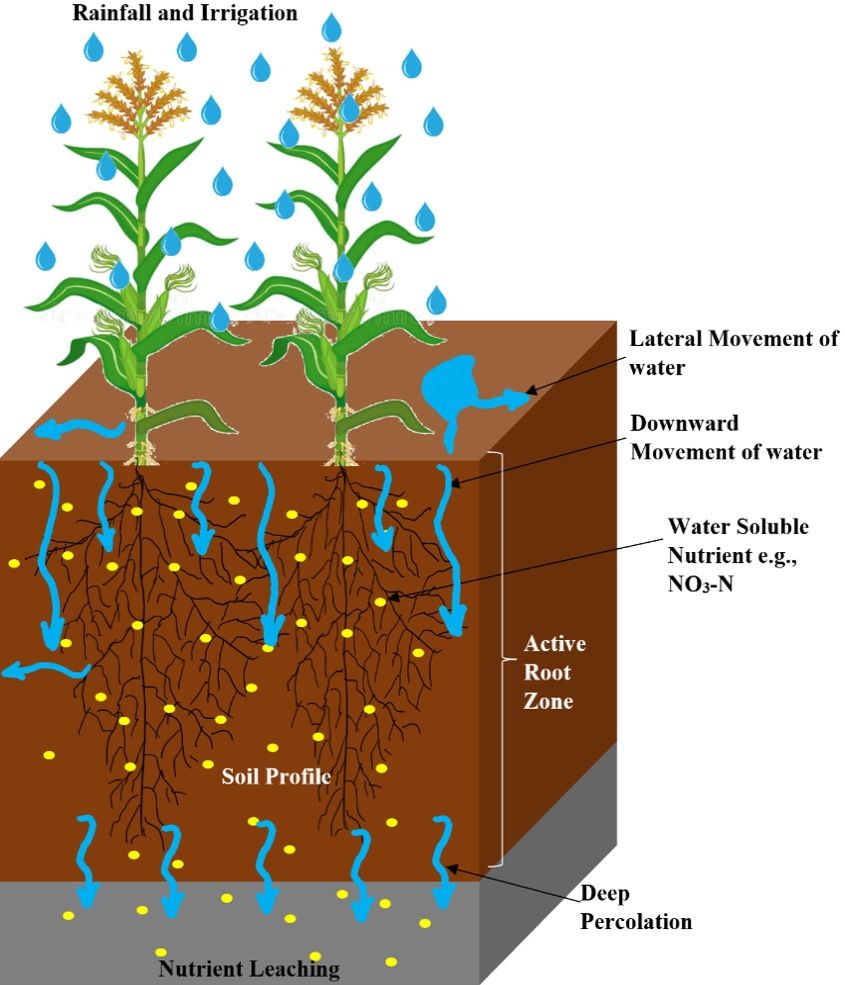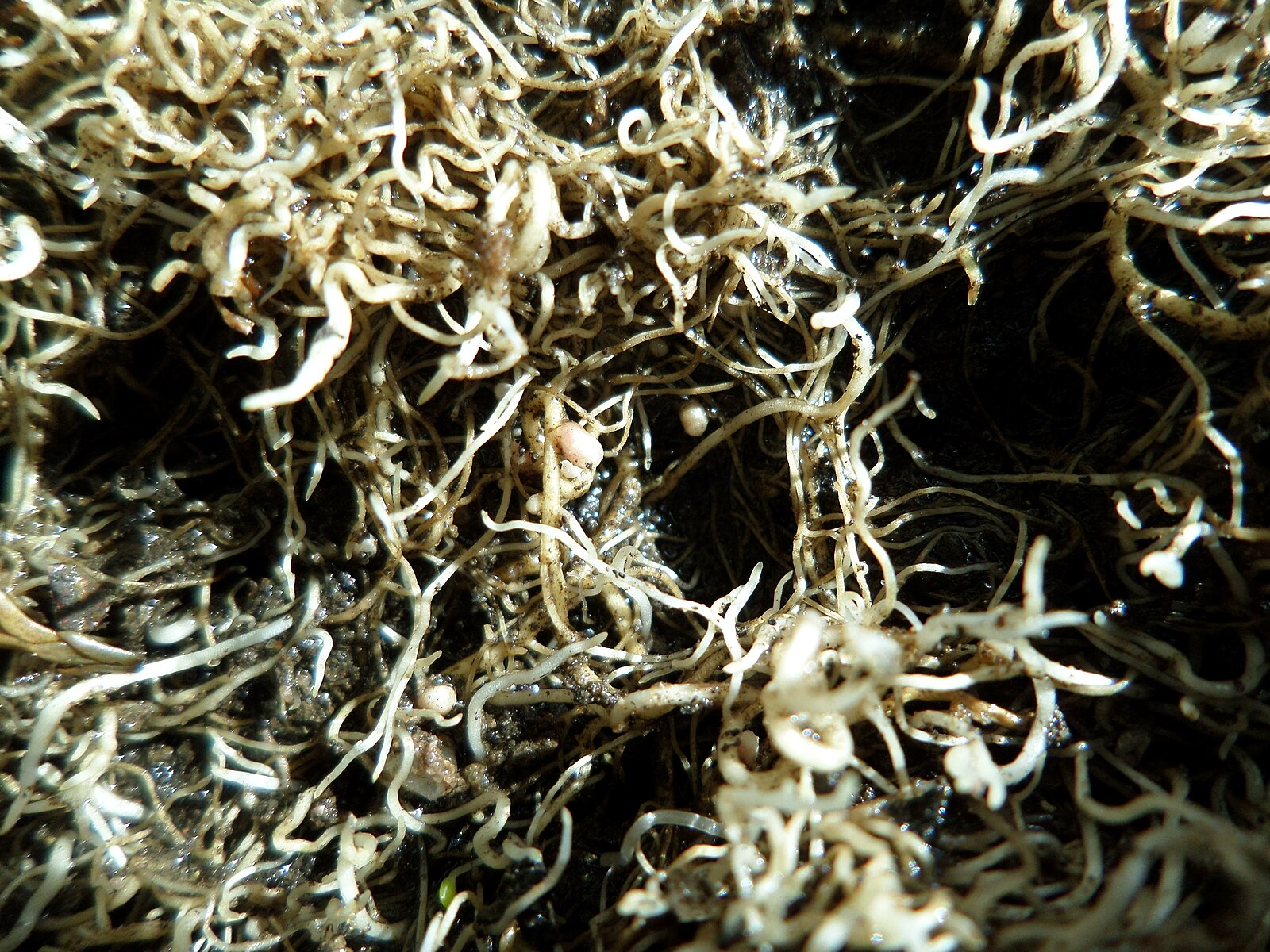IB Syllabus focus:
‘Waterlogged soils reduce growth and promote denitrification/leaching. Some plants host N-fixing bacteria; insectivorous plants supplement nitrogen. Flows include mineral uptake, photosynthesis, consumption, excretion, death, decomposition, ammonification.’
Anaerobic soils present unique challenges for ecosystems, disrupting nutrient cycles and plant growth. These soils drive alternative strategies for survival and alter essential biogeochemical flows.
Anaerobic Soils and Their Characteristics
Anaerobic soils are waterlogged environments in which oxygen availability is severely restricted. Oxygen, being a critical electron acceptor in most biological processes, becomes limiting when pore spaces are filled with water.
Anaerobic Soil: A soil condition where water saturation prevents oxygen diffusion, leading to oxygen-deficient environments that limit aerobic biological processes.
When oxygen is scarce, microbial communities shift from aerobic respiration to anaerobic pathways, altering the balance of the nitrogen cycle and other nutrient flows. These changes slow down plant productivity and affect overall ecosystem stability.
Effects on Plant Growth
Waterlogged soils create several constraints for plants:
Reduced root respiration: Without oxygen, roots cannot carry out aerobic respiration effectively, lowering energy supply for active transport.
Accumulation of toxic compounds: By-products of anaerobic microbial metabolism, such as hydrogen sulfide, may harm plant tissues.
Nutrient loss: Increased denitrification and leaching reduce available nitrogen, essential for plant growth.
This explains why ecosystems such as wetlands, bogs, and rice paddies often support specialised flora adapted to tolerate or bypass oxygen limitation.
Nitrogen Dynamics in Anaerobic Soils
Anaerobic conditions significantly modify nitrogen cycling, particularly by enhancing denitrification and nutrient losses.
Denitrification: A microbial process converting nitrate (NO₃⁻) into gaseous nitrogen (N₂), releasing it into the atmosphere and reducing soil fertility.
In addition to denitrification, leaching occurs, where dissolved nitrates are washed from the soil profile into groundwater or surface water systems.

Schematic showing nitrate (NO₃⁻) moving below the active root zone with rainfall/irrigation, illustrating nutrient leaching from soils. Arrows indicate lateral and downward water movement that transports soluble nitrate beyond plant uptake. This directly supports the syllabus focus on leaching in waterlogged or heavily irrigated soils. Source.
Plant Strategies for Coping with Anaerobic Soils
Nitrogen-Fixing Symbioses
Some plants form symbiotic relationships with nitrogen-fixing bacteria to offset nitrogen losses. These microbes convert atmospheric nitrogen (N₂) into ammonia (NH₃), which plants can assimilate.

White clover (Trifolium repens) roots with pink, leghemoglobin-rich nodules formed by Rhizobium. These nodules demonstrate a nitrogen-fixing symbiosis that supplements plant nitrogen when soils are nitrogen-limited by leaching or denitrification. The pink colour indicates active N fixation. Source.
Nitrogen Fixation: The biochemical process by which certain microbes convert atmospheric nitrogen gas (N₂) into ammonia (NH₃), a biologically available form.
Examples include legumes hosting Rhizobium bacteria and wetland plants forming associations with cyanobacteria. This strategy ensures nutrient availability even when soil nitrogen is depleted by denitrification.
Insectivorous Adaptations
In nutrient-poor soils, such as peat bogs, some plants adopt carnivory. Insectivorous plants like pitcher plants and sundews capture and digest insects to supplement nitrogen.

Labeled diagram of a Nepenthes pitcher showing glands involved in attraction and digestion of prey, illustrating how insectivory supplements nitrogen when soils are nutrient-poor or waterlogged. This reinforces the plant strategy described in the syllabus. Note: the specific A–C gland labels are morphological detail beyond the syllabus, included here to clarify function. Source.
This adaptation allows plants to survive where traditional nutrient acquisition strategies fail, highlighting ecological flexibility in extreme environments.
Biogeochemical Flows in Anaerobic Conditions
Anaerobic soils influence the following key flows in ecosystems:
Mineral uptake: Plants absorb dissolved ions, though efficiency declines under oxygen-poor conditions.
Photosynthesis: Carbon fixation continues, but growth may be constrained by nitrogen limitation.
Consumption: Herbivores depend on plant biomass, which may be less nutritious in nitrogen-deficient systems.
Excretion: Waste returns nutrients to the soil, where decomposition pathways are modified under anaerobic conditions.
Death and decomposition: Slowed by oxygen scarcity, organic matter accumulates, often forming peat.
Ammonification: Microbial breakdown of organic nitrogen produces ammonium (NH₄⁺), which may remain in soils with limited nitrification under anaerobic conditions.
Ammonification: The microbial conversion of organic nitrogen compounds from dead organisms and waste into ammonium (NH₄⁺), a plant-available form.
These flows demonstrate how ecosystem function adapts to reduced oxygen availability, with feedbacks influencing long-term soil and vegetation characteristics.
Ecosystem Implications of Anaerobic Soils
Wetland Formation and Peat Accumulation
Waterlogged soils often support wetland ecosystems, where decomposition is slowed. This results in the gradual accumulation of organic matter, forming peat soils that act as significant carbon stores.
Nutrient Limitation and Biodiversity
Ecosystems dominated by anaerobic soils tend to have lower primary productivity due to nutrient loss. However, they may support unique biodiversity of highly specialised species adapted to nutrient scarcity and anaerobic conditions.
Human Connections
Human activities such as rice cultivation rely on anaerobic soils. These conditions influence global nitrogen cycling, greenhouse gas emissions (e.g., methane from anaerobic decomposition), and agricultural sustainability.
Summary of Key Points
Anaerobic soils restrict oxygen availability, slowing decomposition and plant growth.
Nitrogen losses occur via denitrification and leaching, lowering fertility.
Plants adapt by forming symbiotic relationships with nitrogen-fixing bacteria or adopting insectivory.
Ecosystem flows such as mineral uptake, photosynthesis, and ammonification are modified under anaerobic conditions.
These soils contribute to wetland formation, carbon storage, and unique biodiversity, while also being influenced by human activity.
FAQ
Anaerobic soils form when water saturates the pore spaces between soil particles, blocking oxygen diffusion.
This often occurs in:
Floodplains and wetlands with prolonged standing water.
Agricultural fields subject to over-irrigation.
Clay-rich soils where drainage is naturally poor.
The result is oxygen deprivation, altering microbial activity and nutrient cycling.
Denitrification releases nitrogen gases into the atmosphere, mainly nitrogen (N₂), but also nitrous oxide (N₂O).
N₂ is harmless and replenishes the atmospheric store.
N₂O, however, is a potent greenhouse gas with a much higher warming potential than carbon dioxide, linking anaerobic soils to climate change.
Peat bogs form where waterlogging slows decomposition.
Oxygen deficiency prevents decomposers from breaking down organic matter efficiently.
This causes dead plant material to accumulate over centuries, creating thick carbon-rich layers.
As a result, peatlands act as long-term carbon sinks but are vulnerable to disturbance.
Insectivorous plants produce specialised digestive enzymes or house bacteria that break down insect tissues.
Sundews secrete sticky mucilage containing enzymes.
Pitcher plants fill traps with fluid rich in digestive compounds.
Venus flytraps release enzymes once prey is enclosed.
The digested nitrogen and phosphorus are absorbed directly into plant tissues.
Ammonification provides a steady, though limited, supply of ammonium (NH₄⁺) when oxygen is scarce.
Microbes break down organic nitrogen from dead biomass and waste.
Because nitrification is inhibited under anaerobic conditions, ammonium accumulates instead of being converted to nitrate.
This process is critical for maintaining at least some plant-accessible nitrogen in waterlogged soils.
Practice Questions
Question 1 (2 marks)
Explain why anaerobic soils often lead to reduced plant growth.
Mark Scheme:
1 mark for identifying that lack of oxygen reduces root respiration/energy supply.
1 mark for explaining that this reduces nutrient uptake or overall plant productivity.
Question 2 (5 marks)
Discuss two strategies plants use to overcome nitrogen limitations in anaerobic soils, and explain how these strategies maintain ecosystem function.
Mark Scheme:
Up to 2 marks for describing symbiotic nitrogen fixation (e.g., root nodules with Rhizobium, conversion of N2 to NH3).
Up to 2 marks for describing insectivory (e.g., pitcher plants/sundews digest insects to obtain nitrogen).
1 mark for linking either or both strategies to maintenance of ecosystem function (e.g., ensuring nitrogen availability supports productivity, herbivore nutrition, or community stability).

